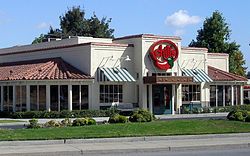Supreme Court gives a break to employers and workers
by CalWatchdog Staff | April 13, 2012 9:46 am
April 13, 2012
By Katy Grimes
California employers have been regulated and mandated to the point of ridiculousness — and unprofitability. But a California Supreme Court decision this week finally gives employers a break—while still giving employees a break.  [1]
[1]
Resolving the increasing uncertainty due to legal hair-splitting by employment lawyers over the scope of an employer’s obligations for meal and break periods, the California Supreme Court ruled this week[2] that an employer’s obligation is only to provide the break periods, but not force employees to take the breaks.
The law states that employees must be provided a 10-minute break within the first five hours of an employee’s shift. And, during an eight-hour shift, employers must provide two 10-minute breaks and a 30-minute meal period.
The decision came down in Brinker Restaurant Corporation vs. Superior Court[3], and is only one of many class action lawsuits on means and rest breaks pending in California. California’s many trial lawyers have made successful practices of suing California’s diminishing employers.
Brinker Restaurant operates Chili’s and Maggiano’s Little Italy.  [4]
[4]
At issue in the state is the rights of employers — those people who stick their necks out, and invest their own money into companies which provide a product or service. These employers hire employees, pay them a wage and provide benefits to produce the product or service.
Attack on employers
But employers in California have been under attack for many years.
In addition to the issue of meals and break periods are the putative overtime laws, and whether employers had to pay overtime after eight hours in a day, or after 40 hours (total) of work in a week. Employers argue that paying overtime after eight hours every day restricts scheduling and production flexibility. Most other states base overtime on the 40-hour work week.
California also does not allow employees to work flexible-schedule weeks, such as four 10-hour days; or three 12-hour days, without paying overtime. Many employees prefer these alternative schedules, and employers find much more production and scheduling flexibility with the alternative schedules.
California’s overtime, and hour and wage laws, are complex and largely appear to be driven by the political party in power.
Overtime was enacted many years ago to compensate employees who were being “overworked” by employers, defined by the government as working employees beyond eight hours in one workday. Overtime law requires employers to pay employees time and a half for working more than eight hours in one day, as well as more than 40 hours in one week. Double-time is paid after 12 hours in one day, and again on the seventh consecutive workday in one week.
In effect through 1997, the old daily overtime rules required only certain industries that had specific wage orders regulating them, to pay overtime daily. Manufacturing and clerical workers were subjected to the daily overtime laws. But construction, mining and logging were not, so they could instead opt to pay daily overtime or defer to the federal standard of paying overtime after 40 hours worked in a workweek.
New law
In 1998, Gov. Pete Wilson signed legislation relieving California’s employers from the state’s daily overtime laws, allowing employers to pay overtime after 40 hours in one week, instead of the daily overtime. Widely hailed as a pro-business move, Wilson’s goal was to give employers and employees more flexibility in production and schedules. Labor union representatives were outraged, and claimed their members would lose income with the overtime change.
Almost immediately, Assemblyman Wally Knox, D-Los Angeles, authored AB60, which was referred to as organized labor’s reaction to Wilson’s elimination of daily overtime. In 1999, Gov. Gray Davis signed AB60, called the “Eight Hour Day Restoration and Workplace Flexibility Act of 1999,” dramatically changing the state’s overtime compensation laws. The act went into effect for most employers on January 1, 2000. However the list of exemptions was long, and included public employees.
The 1999 act’s most dramatic change was the restoration of the daily overtime requirement. Ironically, union employees covered by a collective bargaining agreement were not covered by AB60, nor were public employees.
Federal law, and the vast majority of states, only require that overtime be paid for hours worked in excess of 40 per week. However, California requires that overtime be paid after eight hours work in one workday and after 40 hours work in one workweek.
Along with overtime laws, meal and break periods became regulated. Instead of allowing employees and employers to determine break and meal periods, the government stepped in and overreacted.
Fortunately, the state Supreme Court decision this week brought a modicum of sanity back to the workplace and may put an end to some of the class action lawsuits.
“In a unanimous opinion authored by Associate Justice Kathryn M. Werdegar, the court explained that neither state statutes nor the orders of the Industrial Welfare Commission (IWC) compel an employer to ensure employees cease all work during meal periods,” the California courts reported.
The court also upheld the 30-minute meal break period “during which the employee is at liberty to come and go as he or she pleases.” A meal break must be afforded after no more than five hours of work, and a second meal period provided after no more than 10 hours of work.
The court’s opinion in Brinker Restaurant Corporation v. Superior Court is available on the California Courts Web site[5].
- [Image]: http://www.calwatchdog.com/wp-content/uploads/2012/04/250px-Chilissantaclara.jpg
- California Supreme Court ruled this week: http://www.courtinfo.ca.gov/opinions/documents/S166350.PDF
- Brinker Restaurant Corporation vs. Superior Court: http://www.courtinfo.ca.gov/opinions/documents/S166350.PDF
- [Image]: http://www.calwatchdog.com/wp-content/uploads/2012/04/220px-Maggianos_in_Friendship_Heights.jpg
- California Courts Web site: http://www.courtinfo.ca.gov/opinions/documents/S166350.PDF
Source URL: https://calwatchdog.com/2012/04/13/employers-deserve-a-break-today/